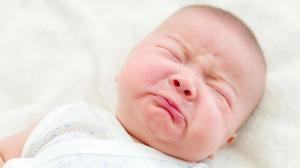You won’t see the tears rolling down the chubby cheeks of babies. But why lovely babies just born without tears perhaps not everyone knows.
Upon entering the world, an infant let out a loud cry. That really makes a difference and brings joy to many families. But if you look closely, you will notice that the cry of an infant is slightly different from that of an older infant in that they will not have tears.

Not many people know the reason why newborn babies cry but have no tears.
Tears, of course, are necessary to protect the eyes and keep them moist. When faced with extreme emotions like sadness, anger, or even happiness, we cry, says Sage Timberline, a pediatrician at the University of California.
That temporary stress triggers a fight-or-flight response that produces tears to further protect the eye. These emotional tears can also help release stress hormones that may have built up over time, which contribute to our feeling of greater relief.
Meanwhile, a child is born with a tear duct that is not yet fully developed. They produce enough tears to cover their eyes and keep them moist, but not enough to form droplets that trickle down those chubby cheeks. After three or four weeks, a baby’s tear ducts are usually mature enough to form tears associated with strong emotions.
Newborn babies’ eyes tend to be dry, and so is their skin. No matter how hot it gets, a newborn baby barely sweats for the first few weeks of life. That’s because the sweat glands aren’t fully functional yet .
Humans have two types of sweat glands, known as eccrine and apocrine glands , both of which are formed in infants even when they have not yet produced sweat. The apocrine glands secrete sweat through hair follicles but are not activated until hormonal changes take place during puberty. Although apocrine sweat is initially odorless, it can become smelly. It’s filled with water and electrolytes, as well as steroids, lipids, and proteins that bacteria can process to produce odors.
The eccrine glands begin to form during the fourth month of pregnancy, appearing first on the baby’s palms and on the soles of the feet. By the fifth month, the eccrine glands cover almost the entire body.
Because babies cannot sweat adequately, they need to rely on caregivers to keep them cool. However, be on the lookout for signs of overheating, including sweating (since babies don’t sweat), warm, flushed skin, rapid breathing, fussiness, and decreased activity of the arms and legs. , Timberline said. If your baby shows signs of heat, take off a layer of clothing or use a fan to keep the air circulating and then monitor.

